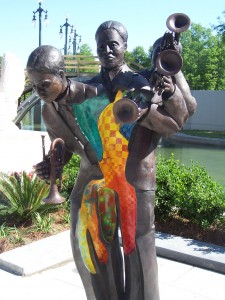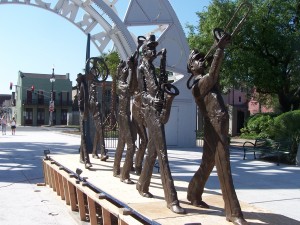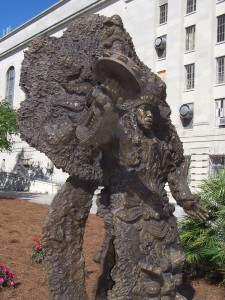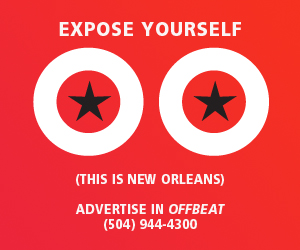The Roots of Music Cultural Sculpture Garden in Armstrong Park is open now, sort of. The project that Mayor C. Ray Nagin shepherded through channels despite some controversy over a lack of public input is partially in place and open. Sculptures celebrating Buddy Bolden, brass bands and Big Chief Tootie Montana are in place
(though the brass band is on a temporary, plywood base). I didn’t see the bust of Sidney Bechet or the sculpture honoring Mahalia Jackson, and workers are still preparing places for the Congo Square and Opera House pieces.
The brass band greets visitors walking in through the Rampart Street entrance, but it’s the least impressive piece – figures in a band flattened in profile. They are, in effect, two-dimensional, and any sense of depth is created by the band marching in two rows. The placement in the middle of the walkway makes a literal sense – where else would you find such a band? – which means that when you look at it, you’re more likely to see people than the greenery behind it, but there’s a startling lack of imagination in it.
More provocative is the bronze (I think) Tootie Montana. It too is pretty literal; no one will have any doubt about what he or she is looking at. The sculpture does bring an additional dimension to his suit, and faces and details that would have been on patches on a real costume emerge (check the back to see this at its best), and that gives Montana an otherworldly quality. Still, the question is what to think of such a solid Mardi Gras Indian. Part of the beauty of Indian costumes is the way the carefully chosen feathers blow and move, but there is no movement whatsoever in this Montana. He’s not as lumpen as photos of the model made him appear, but he’s a man standing his ground because he can’t go anywhere. Then again, perhaps its a tribute to Montana to render him as this hard, solid, powerful figure.
The most adventurous of the pieces is that depicting Buddy Bolden with three trunks, heads and sets of arms emerging from one waist, supposedly to capture the way he moved while playing. Again, it won’t take a PhD in art appreciation to get that, and it would be nice of that invention extended to his face, which is robotic on all three heads. Splashes of color fill his torsos – the only color in the sculptures so far – and I expect we’re too see that as the jazz or music inside him. The  yellows, reds and oranges certainly suggest a fire inside him, but the abstract juxtaposition of colors doesn’t come together when viewed from the front. It’s far more effective when seen as a stripe of startling color when viewed from the sides.
yellows, reds and oranges certainly suggest a fire inside him, but the abstract juxtaposition of colors doesn’t come together when viewed from the front. It’s far more effective when seen as a stripe of startling color when viewed from the sides.
I’ve said before that I’m not convinced that a sculpture garden will bring people into Armstrong Park, or, more accurately, it won’t bring in as many people as taking the fences down would, making it possible for people to use the park the way they use parks. A sculpture garden sounds like something that’s good for you, which is semi-appealing, but not as appealing as a cook-out, a picnic or a place to play.
As a celebration of New Orleans’ culture, it’s also semi-successful (so far, though it’s hard to imagine the aesthetics changing radically based on what’s visible so far). A better celebration of the figures and places that shaped our culture would be to have people bring the same sort of radical imagination to the works that the honored figures brought to their endeavors the first time around.






